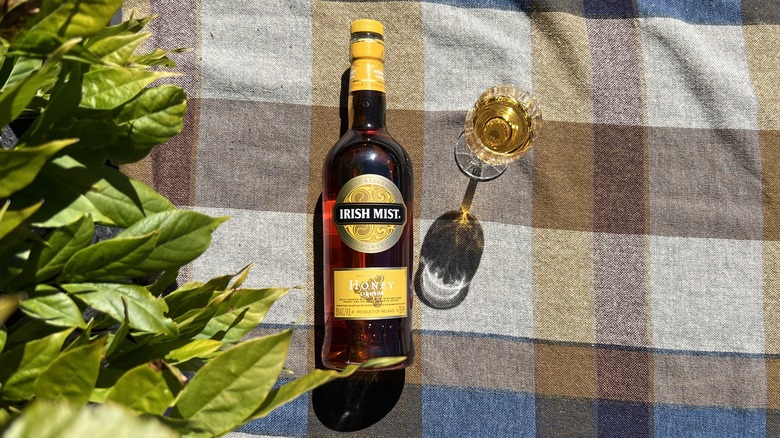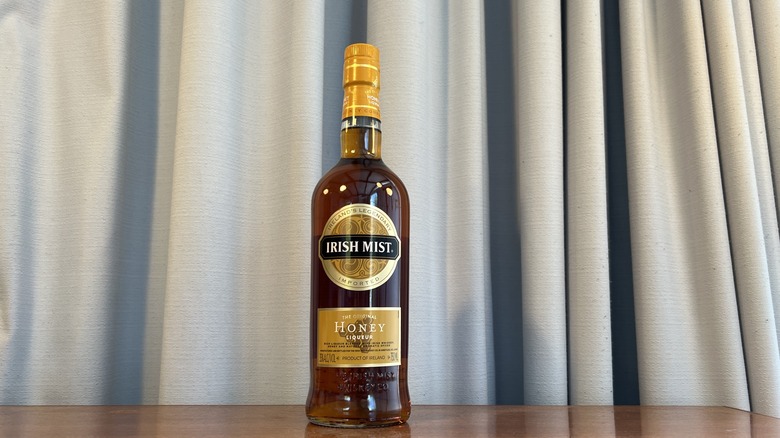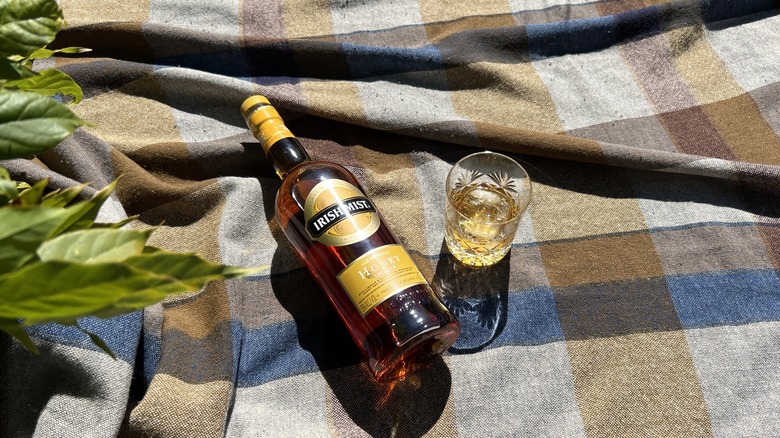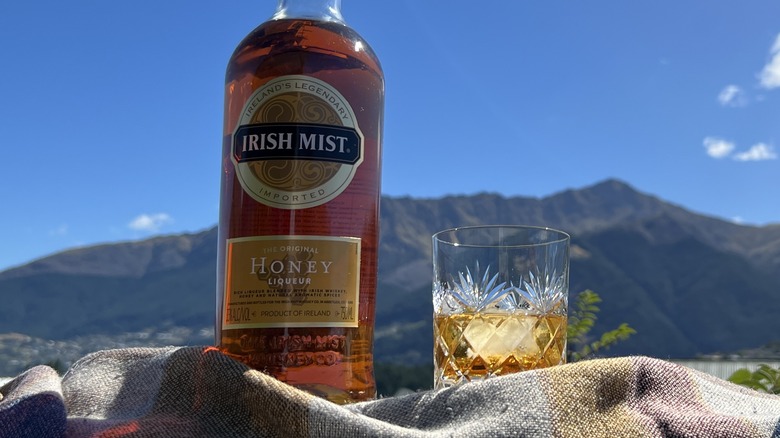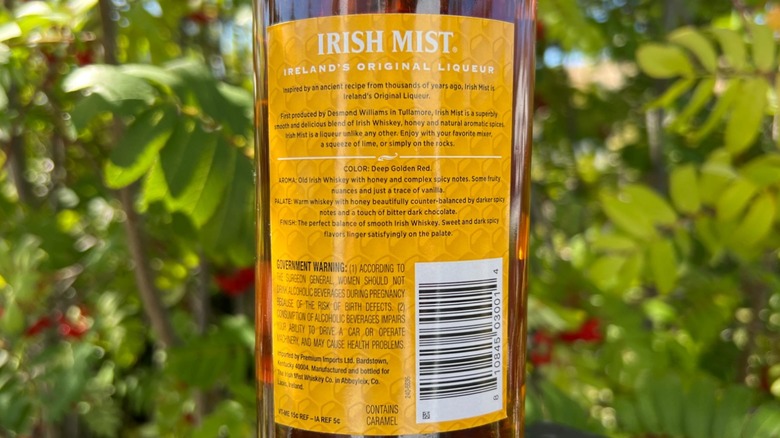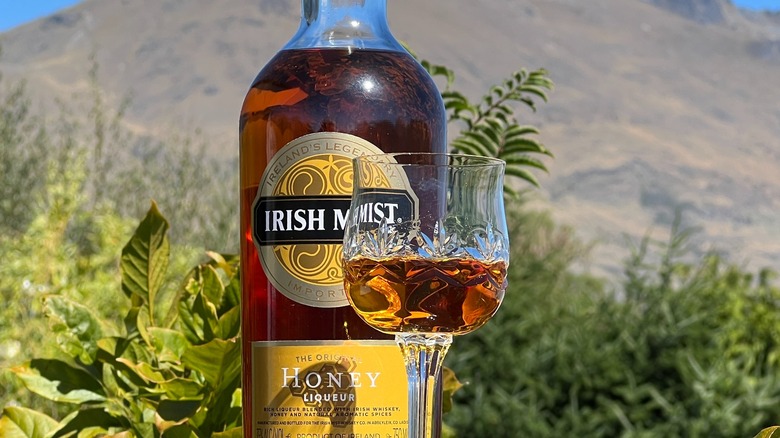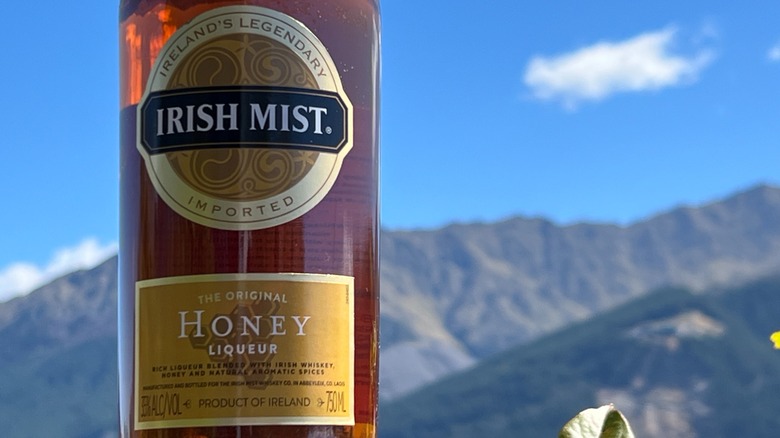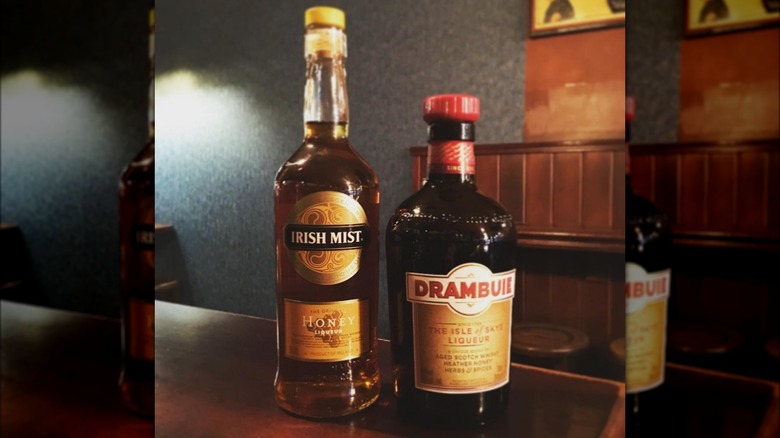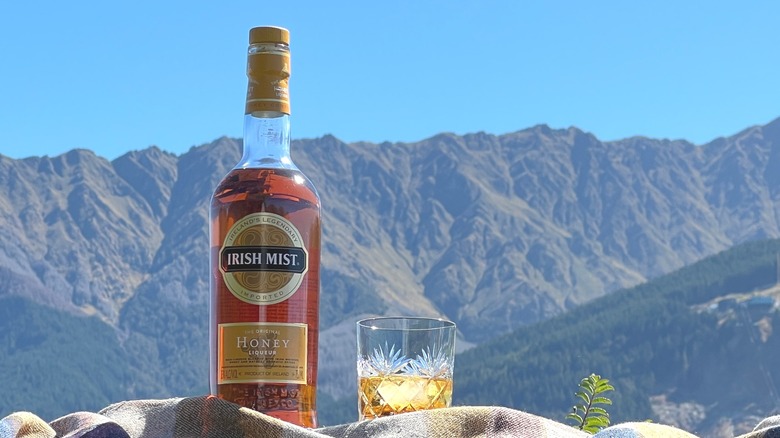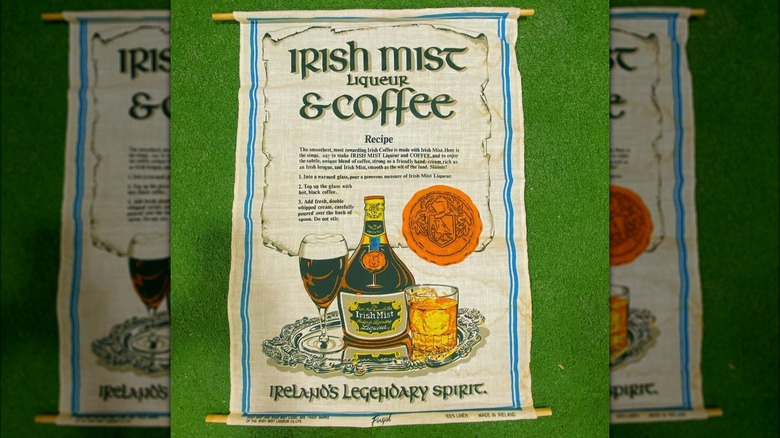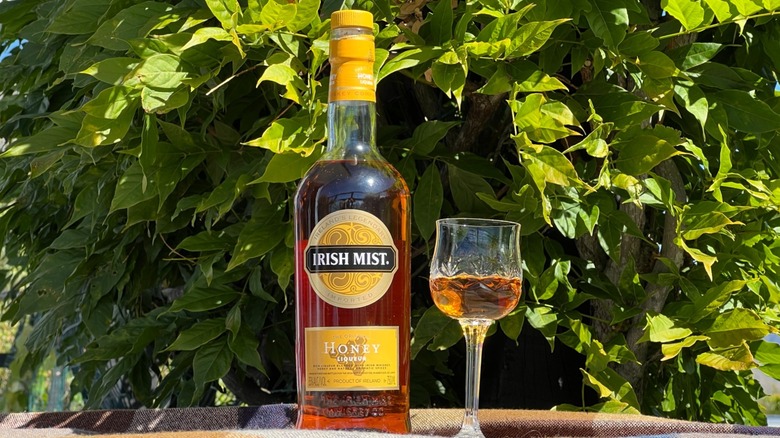Irish Mist Honey Liqueur: The Ultimate Bottle Guide
The world of Irish whiskey is rich, diverse, and historied, but there's a liqueur by the name of Irish Mist that has been at the heart of Ireland's whiskey story since it was first created in 1947. It's a reminder of what makes Irish whiskey the best entry point for beginners while offering a window into its potential as a liqueur.
To help us dive deeper into everything there is to know about Irish Mist, we've spoken to Leslie Word, the brand manager of Heaven Hill Brands, which includes this iconic import. Word characterizes Irish Mist as the "quintessential Irish whiskey liqueur that's like no other, [and] embodies the cheerful and welcoming spirit that Ireland is renowned for around the world." At 35% alcohol by volume, or 70 proof, it's a smooth sipper while also adding spine to a mixed drink or cocktail.
As someone who's worked in spirits marketing, sales, training, and service for over 10 years, I've expressed my honest opinion about this product and approached the sample objectively. While Heaven Hill sent us a sample bottle, this did not affect my opinion of the product and the viewpoints expressed in this article are my own. Let's take a closer look inside the bottle of Irish Mist, exploring its rich history, details about the product, and what it tastes like.
History of Irish Mist
The story of Irish Mist begins with the founding of the Tullamore Distillery by Michael Molloy in 1829, in County Offaly. This distillery was started to produce Irish whiskey, which it did for over 100 years, undergoing a name change to the B. Daly Distillery after the death of Molloy. Irish Mist was born when Desmond Williams, a grandson of the master distiller Daniel Edmund Williams (Tullamore D.E.W.'s namesake), invented the liqueur in 1947.
The creation of Irish Mist was a necessary effort. Desmond Williams needed to sell a large supply of Irish whiskey during a post-war era when sales were hurting. With stocks of B. Daly's Tullamore whiskey that he couldn't find a buyer for, Williams collaborated with a German wine merchant named Fritz Hallgarten to supply Irish whiskey and honey for Hallgarten's production of Glen Mist, a liquor based on these ingredients. This deal stipulated that Williams was free to develop and market his own version, Irish Mist, for the domestic market. Williams' venture would eventually become the Irish Mist liqueur company.
According to brand manager Leslie Word, the recipe hasn't changed since 1947. This means that the Irish Mist you can find in your local liquor store offers the same complexity and balance of bold flavor that Williams landed on more than 75 years ago.
Irish Mist has changed ownership over the years
In 2017, Irish Mist found its current home with Heaven Hill Brands, an American company best known for whiskey brands such as Evan Williams Bourbon, Elijah Craig Bourbon, and Rittenhouse Straight Rye Whisky, among many others. In a diverse family hosting both whiskeys and liqueurs, Irish Mist enjoys distribution throughout the United States.
Over the years, however, this iconic brand has passed through the ownership of many big names, beginning in 1985 when Irish Mist Liqueur was sold to Cantrell & Cochrane, also referred to as C&C. Irish Mist would remain with C&C for 25 years before the brand was bought up by a Scottish distiller, William Grant & Sons, in a transaction that included Tullamore D.E.W. and Carolans Irish Cream Liqueur in 2010. While William Grant & Sons saw the potential for Tullamore D.E.W. in its portfolio, it was quick to sell the two Irish liqueurs to the Campari Group before the end of that year. Seven years later, Heaven Hill added Irish Mist to its portfolio, together with Carolans Irish Cream.
What does Irish Mist taste like?
Irish Mist's first impression on the nose is undeniably honey. There's something pleasantly medicinal in the play of herbs, honey, sugar, and alcohol in the first breath, but the Irish whiskey shines shortly after a syrupy introduction. A dainty floral note also skips through the whole experience, inspiring fresh heather meadow blooms. If you enjoy the smell of honey spread across a freshly buttered piece of wholemeal toast, we've got some good news for you.
On the palate, there's no surprise about the dominance of honey. This is underpinned by subtle creamy vanilla that layers in nicely with Irish Mist's syrupy viscosity. Trailing behind the honey and vanilla is a combination of clove and cinnamon, along with fresh green herbs and heather. All the while, there's a presence of marmalade-like fruitiness. The liqueur's alcohol is aptly masked by its sugar, but there's enough whiskey bite in there to remind you that you're sipping with the grown-ups.
The finish on Irish Mist is long and leaves you with a determined bitter note of cocoa, which pleasantly transitions from its sweetness. This liqueur is intensely sweet, but the rich spice, herbs, and alcohol all do their part to keep this sweetness from becoming overpowering. If you're a whiskey purist reluctant to drink your dram with so much as a block of ice, this probably isn't for you. If you love the whiskey genre and want to settle into something decadent, then Irish Mist is probably your thing.
How is Irish Mist made?
The production process for Irish Mist starts with aged Irish whiskey. "Irish Mist has a foundation of triple-distilled Irish whiskey, aged in oak casks," according to Leslie Word. The aging method for the whiskey that goes into Irish Mist is a four-year process, giving the whiskey time to mellow and mature. "These aged whiskeys are then blended with other Irish spirits to balance the flavor before being married together with spices, herbs, honey, sugar, and water," Word said. "The finished liqueur is filtered to create the bright, golden spirit that is ready for bottling as Irish Mist Honey."
As with many brown spirit products and related liqueurs, caramel color is added to the final product to regulate its hue. This doesn't affect the flavor of the product, nor does it add any real sugar, but helps the producers ensure that the product always looks the same. The actual sugar that goes into this product is part of what makes the difference between liquor and liqueur. Liqueurs tend to be more heavily flavored than most liquors, and are known for trending substantially on the sweeter side. Irish Mist definitely falls into this latter camp.
Today, the production of Irish Mist is no longer in its original town of Tullamore, although it has remained in Ireland. Irish Mist is now produced and bottled in Abbeyleix, County Laois, located southwest of Dublin and south of Tullamore.
How to drink Irish Mist
Irish Mist has a distinct whiskey-based flavor profile, which opens it up to a world of possibilities. If there's a drink you enjoy that's whiskey-based, there's a good chance you'd enjoy a version with Irish Mist in whiskey's place. Leslie Word, the spirit's brand manager, recommends trying the liqueur "straight up, over ice, or as a long drink with cola, soda, tonic, or ginger ale. As a cocktail, it is a great substitute for whisky/whiskey. It also makes a rich and unique Irish coffee." Therein lies the potential of Irish Mist. The honey and spice this liqueur integrates into drinks, whether hot or cold, work hand-in-hand with the whiskey strength it delivers.
In terms of occasion, Irish Mist is a great digestif or aperitif to settle the stomach after a large meal, or even to get the appetite going. It's also a tasty sipper for sitting by the fire and reminiscing about the days of old.
For social situations, Irish Mist is a generous cocktail ingredient. Word recommends the "Tullamore Sour" — a twist on the classic frothy whiskey sour. This variation adds 1½ ounces of Irish Mist with 1 ounce of Irish whiskey, as well as ½ ounce of Dubonnet, an aromatic wine-based aperitif. Replacing some of the straight-up whiskey with Irish Mist removes the need for sugar syrup in the cocktail. The Tullamore Sour was designed with Irish Mist in mind by Lynn House, a Heaven Hill spirits specialist and mixologist.
Is Irish Mist expensive?
Retailing online for between $25 and $30 per bottle at the time of writing, Irish Mist is very affordable. As a liqueur, this is a pretty cost-effective option and a fairly low commitment for the liquor cabinet. This price bracket is also not offensively low, meaning that customers going in with no prior knowledge can usually predict that the liquid inside the bottle isn't going to strip the paint from their walls.
Irish Mist is among a price bracket it shares with other liqueurs of a similar ilk, such as Frangelico Hazelnut Liqueur or Baileys Irish Cream. Irish Mist is widely available from online retailers across the U.S. and around the world, and is sold in 750 milliliter bottles and a 375 milliliter half-bottle size. The latter is a suitably cheap option, ranging a dollar or two above or below $15 apiece, at the time of publication, for those not quite ready to commit to a full-sized bottle (although these smaller vessels can be a bit harder to come by).
Irish Mist vs Drambuie
Perhaps Irish Mist's most famous competitor is Drambuie liqueur, another whisky-and-honey concoction. While Irish Mist showcases whiskey from the Emerald Isle, Drambuie famously uses Scotch whisky. Despite their differences, these two liqueurs share a few flavor similarities. Both of these products use heather honey, from which they derive their sweetness and layered flavor. To round out its flavor profile, Drambuie also uses herbs and spices, not unlike the array of aromatic spices that contribute to Irish Mist's complexity.
In terms of flavor, Irish Mist and Drambuie are more alike than different. Both lead heavily with their honey character and are generously sweet. Drambuie can be a little more prominent on the spice notes, while Irish Mist sways more toward herbal qualities. The price tags on Irish Mist and Drambuie, however, are further apart than their flavor profiles, with the latter being more costly. A bottle of Drambuie retails for closer to $45 per bottle, typically $15 to $20 more expensive than Irish Mist, at the time of publication.
Ireland's first liqueur
An easy fact to come by is one that the brand is very proud of, and rightly so. "Irish Mist was the first liqueur to be produced in Ireland when commercial production began in 1947 at Tullamore, County Offaly," Leslie Word said. With a little help from his German friend Fritz Hallgarten, Desmond Williams was a pioneer in the Irish whiskey industry, and his opportunism resulted in a product that has become the stuff of legend.
This is quite impressive when you consider how many Irish liqueurs there are today. From Irish cream liqueurs such as Baileys and Carolans to coffee liqueurs such as Shanky's Whip — these all follow in Irish Mist's footsteps. There are even several similar Irish whiskey and honey liqueurs on the market, including Dubliner Whiskey & Honeycomb and Tullamore D.E.W. Honey. The latter is interesting, given the family connection between the real D.E.W. (Daniel Edmund Williams), and his grandson who invented Irish Mist.
Whisky based on an ancient recipe
As the bottle proudly states and Leslie Word explains, the recipe for Irish Mist is inspired by an Irish recipe that, according to legend, was enjoyed a very long time ago. "The chieftains and nobles of Ireland's ancient clans throughout the centuries had drunk heather wine, a spirit combined with honey, spices, and herbs. However, the secret of this legendary drink disappeared with the last great exodus of the Irish Earls in 1691, an event that has passed into Irish history as 'The Flight of the Wild Geese,'" Word stated.
When developing the formula for Irish Mist, Desmond Williams encountered a manuscript that featured a long-lost recipe for heather wine, and he utilized this when creating his new liqueur, according to Word. "Williams recognized it as the ancient recipe for heather wine, and transformed it into Irish Mist," Word said.
Keeping Irish distilling alive
One key element of everything you need to know about Irish whiskey is that the industry very nearly went down the drain during the mid-20th century. Around the time when Desmond Williams was at the helm of the B. Daly Distillery, sales of Irish whiskey were grinding to a halt. Through fortuitous timing, Williams was able to pivot to using Irish whiskey for his sweet new honey liqueur. Eventually, production of the liqueur at the distillery overtook that of whiskey, and Irish Mist endured while the B. Daly Distillery closed in the 1950s.
Gaining appreciation and commercial interest overseas meant not only that Irish Mist liqueur could survive, but that Ireland's distilleries had a lucrative sales channel to keep its blood pumping. After exhausting leftover supplies of whiskey from the B. Daly Distillery and another resource, the Kilbeggan Distillery, Irish Mist required a regular stream of supply from notable surviving distilleries such as Powers Distillery and Midleton Distillery.
